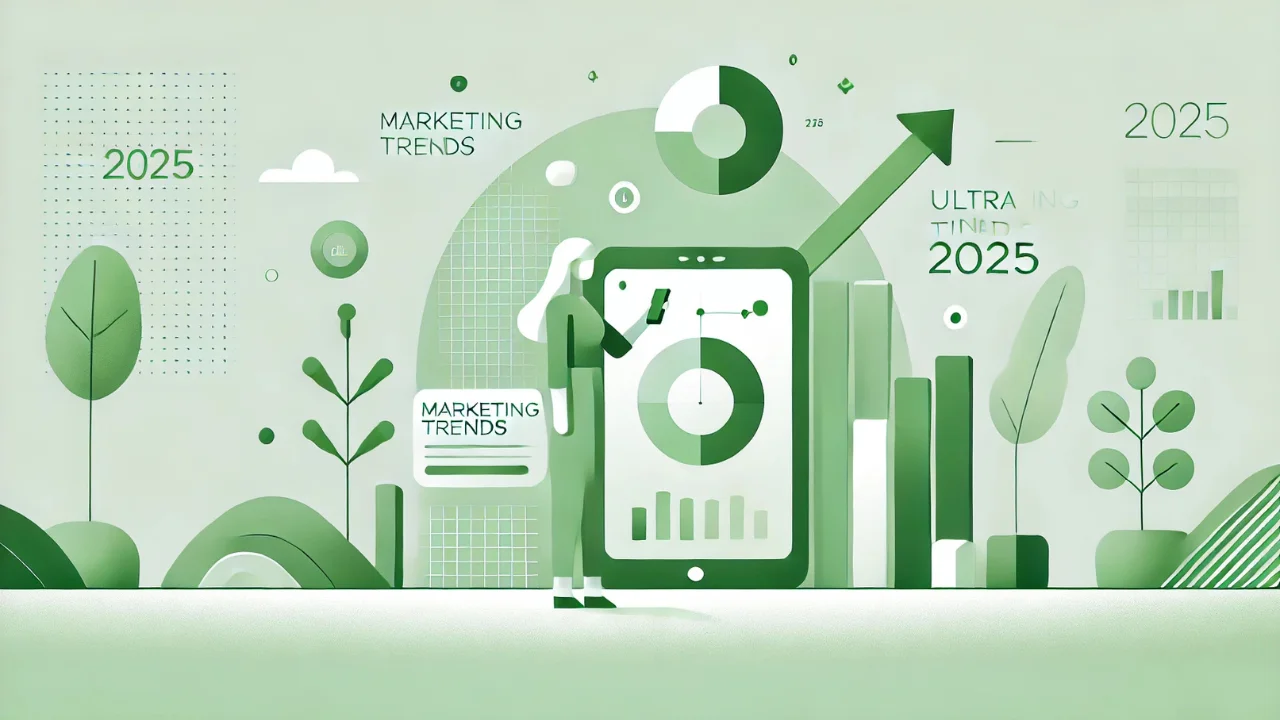Get acquainted with marketing trends for 2025 and discover how to lead the change, not follow it.
Trends are changing, evolving, and coming back constantly, especially in the marketing industry. Technological advancements, shifting consumer expectations, and innovative strategies are key factors shaping the market in 2025. Brands that adapt their dynamics to the situation on the market are the ones that will thrive in this evolving ecosystem.
Why is it important to keep up with marketing trends?
Emerging trends are reflections of consumer behavior, technological innovations, and industry evolution. Therefore, keeping abreast of trends is what allows businesses to:
- Remain relevant competitor in the market — adopting new marketing strategies early gives an edge over others in the industry and helps maintain brand relevance by showcasing innovation and modernity.
- Enhance customer experience — trends are the hints to the efficient marketing since they are reflections of evolving consumer preferences.
- Drive innovation — early introduction of tools like AI or social media platforms can improve efficiency and reach.
- Enhance ROI — marketing efforts are optimized for maximum impact and cost-effectiveness.
- Face challenges seamlessly — observing the market from the business perspective is essential to adapt quickly to dynamic situations, for instance, to the current situation, where, according to predictions, in 2025 about 50 percent of users will either abandon or limit their social media usage (the top channel for digital marketing), which can significantly impact the future of the market.
What are key trends in marketing in 2025?
This article explores nine of the most transformative marketing trends that will define 2025, which are:
1. Hyper-personalization and AI product recommendation
Consumers current perceptions about personalization and recommendations have changed from useful but not a “must-have” to an expectation and necessity. These are implemented by e-commerce platforms (Amazon, Sephora), social media (TikTok, Instagram), and entertainment platforms (Spotify and Netflix).
- Hyper-personalization is an advertising strategy developed on the basis of traditional personalization, among others, by the implementation of machine learning and artificial intelligence to create customized experiences for each recipient. This strategy, combined with human-generated content and intuition, helps, among other things, to attract customers, enhance their engagement and loyalty, and increase profits.
- AI product recommendations are suggestions customized with AI and machine learning algorithms based on the target audience’s behavior and preferences, their values, and their needs. Through the introduction of personalized recommendation systems, businesses can achieve, among other things, sales growth and order overall value and enhanced customer experience.
2. AR and VR
A couple of years ago, augmented reality (AR) and virtual reality (VR) were mainly associated with the gaming industry, but now these tools are implemented in retail by brands like IKEA, Zalando, Mac, or Sephora. Features like virtual try-ons for clothing and makeup, or viewing furniture in one’s home before purchasing, are going to drive engagement, reduce purchase hesitation, and bridge the gap between online shopping and physical experience.
3. Video marketing
Video content was always used to advertise. Now, however, with platforms like YouTube, TikTok, and Instagram, it has transformed, since this trend combines entertainment with convenience, creating a compelling sales channel.
- Dominance of short video and live content
Short-form and live video shopping experiences are becoming the norm. Many platforms have already introduced elements that resemble TikTok content, like, for instance, Instagram Reels or YouTube Shorts, which enable, for instance, live Q&As and product launches.
- Ongoing marketing focus on video platforms
Companies are shifting their advertising budgets to video platforms to increase audience engagement due to the decline in interest in traditional TV.
4. UGC and micro-influencers
In 2025, as the experts predict that by 2026 even 90% of the internet may be synthetically generated, people are craving more genuine human content and authenticity. They want to interact with companies as human beings and not just through automated interactions.
- User-generated content (UGC) is every type of content that users post on their social media profiles, it may resemble the one posted by influencers or affiliate partners, but it is not sponsored. According to one of the research studies, over 80% of consumers reported that UGC improves their trust in brands and product discovery.
- Brands are increasingly collaborating with micro-influencers due to their niche audiences and high engagement rates, as they provide authentic connections with target audience and a cost-effective alternative to celebrity endorsements.
5. Omnichannel approach: social channels as the search and sales engine
In 2025 businesses will focus on integrating their digital marketing efforts across websites, social media, mobile apps, and physical stores—blurring the platform boundaries—while customers will look for genuine opinions and content.
- Social media as a source engine
Social media platforms such as Instagram and TikTok transformed the digital market while they became search engines of the new generations, which are turning to social media platforms to find all kinds of information. People see them as more trustworthy and authentic than traditional searches because the authors of the information are real consumers, proving that genuine community engagement is key to building trust and loyalty in 2025.
- Social media as a sales engine
Social media is evolving into a powerful sales engine, seamlessly blending content and commerce. Platforms like Instagram, TikTok, and Facebook now offer integrated shopping features, enabling users to discover, engage, and purchase products directly within the app.
6. Zero-party data collection and prioritizing data privacy
With increased privacy regulations, brands will depend more on zero-party data (information that customers willingly share). Through this approach, marketers may develop highly targeted campaigns building trust without invading privacy and also offer value in exchange for data such as personalized discounts or carefully chosen content.
7. Sustainable and purpose-driven marketing
In 2025, society is more environmentally aware than ever before. Brands that authentically promote sustainability—through eco-friendly products, ethical marketing plans, and transparent practices—will resonate with this growing segment of socially responsible shoppers.
8. AI: efficient use of data, rather than generating content
Many brands and industries in the early days of widely available AI became excited about using it for everything. However, it has become apparent that the market should be more balanced. In 2025 AI will stay the marketing trend and significant tool in the industry, although its role will shift from content generation to utilizing it for faster, smarter decision-making and optimization.
Summary
The 2025 top marketing trends encourage marketers to focus on quality rather than quantity. Strategic integration of AI tools enhances the individual customer experience, among other things, through personalized recommendations and helps marketing professionals streamline content production by focusing on key channels and prioritizing metrics that really matter to businesses. It is evident now that combining AI with the power of authentic human connections that foster trust and long-term customer loyalty ultimately delivers the most sustainable and impactful results.
To conclude, key trends that will shape the marketing industry in 2025 are:
- Hyper-personalization, AI product recommendation engines creating crafted experiences for each recipient.
- Augmented reality and virtual reality.
- Video marketing and dominance of short video content and video platforms.
- User-generated content marketing and micro-influencers.
- Omnichannel approach, understood as the continuing blurring of platform boundaries, e.g., evident in social media channels used as the search and sales engines.
- Zero-party data collection and prioritizing data privacy.
- Sustainable and purpose-driven digital marketing strategy.
- AI data analysis, seen as efficient use of data, rather than generating content.




